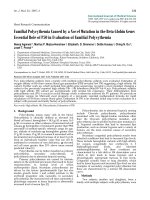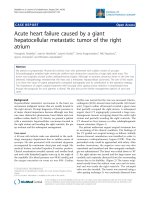Keratomycosis caused by a rare fungus: Exserohilum rostratum
Bạn đang xem bản rút gọn của tài liệu. Xem và tải ngay bản đầy đủ của tài liệu tại đây (84.59 KB, 3 trang )
Int.J.Curr.Microbiol.App.Sci (2019) 8(2): 938-940
International Journal of Current Microbiology and Applied Sciences
ISSN: 2319-7706 Volume 8 Number 02 (2019)
Journal homepage:
Case Study
/>
Keratomycosis caused by a Rare Fungus: Exserohilum rostratum
Parul Punia*, Nidhi Goel, Kausalya Kaushik and Uma Chaudhary
PGIMS ROHTAK, India
*Corresponding author
ABSTRACT
Keywords
Keratomycosis,
Rare Fungus:
Exserohilum
rostratum
Article Info
Accepted:
10 January 2019
Available Online:
10 February 2019
Keratomycosis is an invasive fungal infection of the cornea which usually occurs
following corneal trauma by vegetative material. It is usually caused by hyaline fungus
such as Aspergillus, Fusarium and Acremonium, but rare case reports with phaeoid fungus
have been reported. We report here a case of keratomycosis caused by Exserohilum
rostratum. E. rostratum is a dematiaceous fungus that has been known to cause sinusitis
and subcutaneous infections but it has rarely been reported to be a cause of keratomycosis.
A 60 year old man presented with decreased vision in the left eye since 1 month following
trauma. He was diagnosed to have corneal ulcer for which the patient underwent two
therapeutic keratoplasty and was given Moxifloxacin. But there was no improvement in
the vision. Later E. rostratum was isolated from his corneal scrapings. Topical natamycin
was applied and oral itraconazole was started to which the patient vision improved
gradually. Although E. rostratum is a rare cause of keratomycosis, but if diagnosed on
time and treated appropriately, it can result in complete resolution of vision.
The phaeoid fungus, Exserohilum which is
usually
the
causative
agent
of
phaeohyphomycosis
affecting
skin,
subcutaneous tissue and paranasal sinuses has
only occasionally been associated with
mycotic keratitis.3 Owing to rarity of this
infection in the eye, there are no set
guidelines for its management. Reports on
treatment of mycotic keratitis with this fungus
have largely been unsatisfactory, but
according to some studies, early identification
and treatment is a key to preserving vision in
such infections.
Introduction
Keratomycosis is an invasive fungal infection
causing inflammation and ulceration of the
cornea. It is amongst the leading causes of
visual morbidity and blindness especially in
developing countries like India.1,2 It usually
occurs following traumatic injury to the
cornea by vegetative material contaminated
with saprophytic fungus. Though the profile
of mycotic keratitis agents varies according to
geographical location and climate, but most of
the cases reported have been caused by
hyaline fungus such as Aspergillus, Fusarium
etc. Rare cases have been attributed to
phaeoid fungus like Alternaria, Curvularia,
Bipolaris etc.3
Here we report a case of keratomycosis by
Exserohilum
rostratum
in
an
old
immunocompetent patient with history of
trauma to his eye.
938
Int.J.Curr.Microbiol.App.Sci (2019) 8(2): 938-940
were observed. Based on KOH report, topical
natamycin was administered to the patient.
Culture on Sabouraud dextrose agar (SDA)
with antibiotics showed blackish brown
velvety colony with black pigment on reverse.
On Lactophenol cotton blue (LPCB)
preparation, phaeoid hyphae along with large,
brown pigmented, thick walled, ellipsoidal
multiseptate conidia with very prominent
protruding truncate hilum were observed.
Based on these characteristics, the isolate was
identified as Exserohilum rostratum (Fig. 1).
Topical natamycin was continued and oral
itraconazole 100mg twice daily was started.
The patient responded well to treatment and
his vision gradually improved.
Case report
A 60 year old man presented with decreased
vision in the left eye since 1 month. He gave
history of trauma to the left eye by some
vegetative material while working in the
fields. On ocular examination, he was
diagnosed to have corneal ulcer with feathery
edges. He was started on topical
moxifloxacin, but the vision did not improve.
He underwent two therapeutic keratoplasty,
which also failed to improve the vision. His
corneal scrapings and pus sample from the
corneal ulcer were collected under aseptic
precautions and sent to Microbiology
Department. On KOH examination of both
samples, thick, dematiacious, septate hyphae
Fig.1 LPCB showing Exserohilum spp. from SDA
Other common moulds causing keratomycosis
include mainly the hyaline moulds such as
Aspergillus,
Fusarium,
Acremonium,
Penicillium.
Discussion
Exserohilum spp. is a frequently encountered
environmental mould present in the soil,
vegetation and rotting wood. The infections
caused by this fungus are commonly found in
hot and humid areas such as India, Israel and
the southern United States.4 This fungus is
rarely pathogenic to humans and is mainly
responsible for infections of skin and
subcutaneous tissues. Rare case reports of
keratomycosis by Exserohilum spp. have been
reported.3 Various studies have documented
the incidence of Exserohiulm spp. causing
keratomycosis ranging from 1.3%-. 6.6%.5,6,7
Amongst the common risk factors associated
with Exserohilum keratomycosis has been
attributed to be trauma to the cornea by
vegetative material, long term therapy with
antibiotics and corticosteroids, with trauma
being the most specific risk factor.8,9 Our
patient, who is a farmer, had a history of
penetrating injury to his eye by some
vegetative material while working in the
fields, following which he developed
939
Int.J.Curr.Microbiol.App.Sci (2019) 8(2): 938-940
keratomycosis. Damage to the ocular tissue
leading to breach in corneal epithelium
permits invasion of the fungus into cornea
progressing to keratomycosis.8 This patient
was earlier started on antibiotics for long
period which could be another factor leading
to mycotic keratitis.
The genus Exserohilum has three pathological
species
namely,
E.rostratum,
E.
10
longirostratum, and E.macginnisii.
The
most common species causing human
infections is E.rostratum, which is the
causative agent in this case also. All these
three species have a characteristic protruding
hilum and can be differentiated by their
morphological features of their conidia.
Since, keratomycosis by Exserohilum spp. is
rare, there is no standard treatment protocol
for it. Our patient responded well to topical
natamycin and systemic itraconazole. Many
studies have reported good response with
topical
natamycin
and
sysyemic
itraconazole.3,4 Therapeutic keratoplasty done
twice in this patient did not improve the
vision. A few studies have shown that
therapeutic keratoplasty is not very useful in
keratomycosis by Exserohilum spp. in
contrast to other fungal agents causing
keratomycosis.8
Hence
we
conclude
that,
although
Exserohilum rostratum is a rare cause of
corneal ulcer, but it should be kept as one of
the differential diagnosis if daematicious
fungus is being suspected. Oral itraconazole is
a promising drug in such cases. If this
infection is diagnosed timely and appropriate
treatment started, the vision may improve
significantly.
References
1. Thomas PA. Current perspectives on
ophthalmic mycoses. Clin Microbiol Rev.
2003; 16: 730-97.
2. Gopinath U, Sharma S, Garg P, Rao GN.
Review
of
epidemiological
features,
microbiological diagnosis and treatment
outcome of microbial keratitis; experience over
a decade. Indian J Ophthalmol. 2009; 57: 2739.
3. Thomas PA. Fungal infections of the cornea.
Eye. 2003; 17: 852-62.
4. Joseph NM, Kumar A, Stephen S and Kumar
S. Keratomycosis caused by Exserohilum
rostratum. Indian J of patho & microbial.
2012; 55: 248-9.
5. Sengupta S, Rajan S, Reddy PR,
Thiruvengadakrisnan K, Ravindran RD,
Lalitha P etal. Comparative study on the
incidence and outcomes of pigmented versus
nonpigmented keratomycosis. Indian J
ophthalmol. 2011; 59: 291.
6. Arora U, Gill PK, Chalotra S. Fungal profile of
keratomycosis. Bombay Hosp J.2009;51:32-7.
7. Bharathi MJ, Ramakrishnan R, Vasu S,
Meenakshi, Palaniappan R. Aetiological
diagnosis of microbial keratitis in South Indiaa study of 118 cases. Indian J Med Microbiol.
2002; 20: 19-24.
8. Rathi H, Venugopal A, Rameshkumar G,
Ramakrishnan R, Meenakshi R. Fungal
keratitis caused by Exserohilum, An emerging
pathogen. Cornea. 2016; 35: 644-6.
9. Rautaraya B, Sharma S, Kar S, Das S, Sahu
SK. Diagnosis and treatment outcome of
mycotic keratitis at a tertiary eye care center in
Eastern India. BMC Ophthalmology 2011; 11:
39.
10. Peerapur BV, Rao SD, Patil S, Mantur BG.
Keratomycosis due to Eserohilum rostratumA case report. Indian J Med Microbiol. 2004;
22: 126-7.
How to cite this article:
Parul Punia, Nidhi Goel, Kausalya Kaushik and Uma Chaudhary. 2019. Keratomycosis caused
by a Rare Fungus: Exserohilum Rostratum. Int.J.Curr.Microbiol.App.Sci. 8(02): 938-940.
doi: />940









